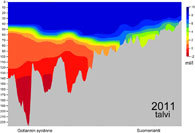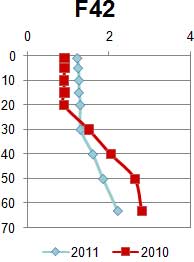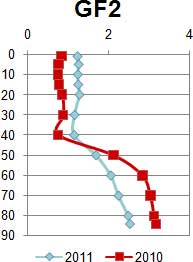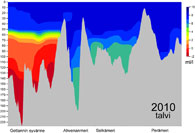Press release 2011-02-17 at 12:00
There has been no improvement in the oxygen status of the Baltic Sea’s main basin and the deep waters of the Gulf of Finland. The results of the research vessel Aranda’s winter monitoring tour indicate that the saline, but oxygen-deficient, sea water that entered the Baltic from the Danish sea area last year remains a strong influence on the main basin of the Baltic Sea and in the Gulf of Finland. Due to the waters mixing, phosphorus levels in the Gulf of Finland’s surface waters are higher than last year. By contrast, phosphorus levels are in decline in deep waters.
Aranda’s three-week winter monitoring tour studied the salt, oxygen and nutrient contents, and plankton levels, in the Gulf of Finland, Aland Sea, Bothnian Sea and Bothnian Bay, and the Baltic Sea proper in the sea basin’s northeastern and middle sectors.
Compared to last year, deep-water oxygen levels have not improved significantly. The figures below illustrate the salt and oxygen levels of the Baltic Sea main basin and the Gulf of Finland, in the winters of 2010 and 2011. (Figure 1)
|
|
|
|


|
|


|
|
C
|
|
D
|
|
Figure 1. Salt and oxygen levels in the Baltic Sea main basin, from the Gotland deep to the Gulf of Finland in January 2010 and 2011: A) Salinity in 2010, B) Salinity in 2011, C) Oxygen level in 2010, D) Oxygen level in 2011.
|
This winter, phosphorus levels in the Gulf of Finland’s surface waters are higher than last year; on the other hand, in deep waters they are lower than the previous year, indicating that the waters are now better mixed and phosphorus has moved from the depths towards the surface (Figure 2). Higher levels of phosphorus at surface level are likely to increase the amount of blue-green algae blooms next summer. However, no forecast for algae blooms will be made until just prior to the summer, when we will know how nutrient levels are likely to develop during the late winter and spring.
|
|
|
|

|
|

|
|
|
|
|
|
Figure 2. Phosphate phosphorus levels in the winters of 2010 and 2011, stations LL7 (central Gulf of Finland), XVI (eastern Gulf of Finland, coast of Finland), F42 (mouth of the Gulf of Finland, southern side) and GF2 (central Gulf of Finland, coast of Estonia). Red line: January 2010; blue line: January 2011. Vertical axis: depth of water
|
Gulf of Bothnia fares better
No significant changes were recorded in the Gulf of Bothnia, compared to last winter’s status. The threshold separating the Gulf of Bothnia from the Baltic Sea main basin denies the Baltic Sea’s mostly saline, oxygen-deficient waters access to the Gulf. The Gulf of Bothnia has low phosphorus levels. This means that, because its deep waters do not suffer from oxygen depletion, phosphorus cannot be released from the seabed, as occurs in the main basin of the Baltic Sea and the Gulf of Finland (Figure 3).
|
|
|
|


|
|


|
|
C
|
|
D
|
|
Figure 3. Salt and oxygen levels from the main basin of the Baltic Sea to the Bothnian Bay, January 2010 and January 2011. A) Salinity in 2010, B) Salinity in 2011, C) Oxygen level in 2010, D) Oxygen level in 2011.
|
Abundance of Mertensia ovum remains the same
The abundance of Mertensia ovum was monitored in the Gulf of Finland. Abundances of Mertensia ovum remained at the levels observed last winter. Mertensia ovum, or the arctic comb jelly, was observed at all stations, all the way to the easternmost part of the Gulf of Finland. The greatest abundances (2,800 individuals per square metre) were, however, observed in central Gulf of Finland, whose deep waters are some per mils saltier than those in the east. The arctic comb jelly is a salt water species, and the salinity of the northern Baltic Sea barely meets the minimum level required for its survival. Once again, no observations were made of the American comb jelly in Finnish territorial waters.
Further information:
Juha Flinkman, Chief Scientist, Finnish Environment Institute SYKE, Tel. 040 750 3911, firstname.lastname@ymparisto.fi
Ctenophores:
Maiju Lehtiniemi, Research Specialist, Finnish Environment Institute SYKE, Tel. 040 725 5085, firstname.lastname@ymparisto.fi
Aira Saloniemi, Chief Editor for Web Services, Tel. 0400 148875, Finnish Environment Institute SYKE, firstname.lastname@ymparisto.fi